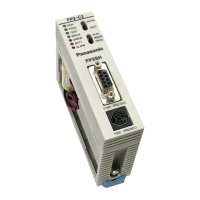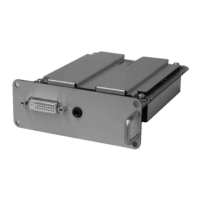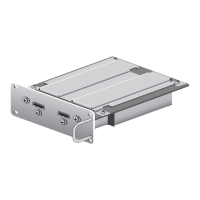Positioning
Temperature Control
■ New PID Command (F356 EZPID) Produces a Temperature
Control Program only in a Single Line.
■ Multi-point PID control
Modbus-RTU
Multiple temperature
controllers
Easy unification of
data management
The high-level PID control easily achieves high-speed, high-accuracy
multi-point temperature control.
R0
Control code
Y0
F356 EZPID, WR1, WX1, DT0, DT100
Measured value Target value Output value Output address
When using the
previous F355 command
• Target value
• Control code
• PID control elements
When using the new
F356 PID command
• Target value setup
• Auto-tuning execution
Program
Only a
single line
Parameter setup
Auto-tuning setup
Start bit ON
Auto-tuning end
Start bit OFF
Parameter storage
PID command execution
Bit processing
Timer set value
conversion
PWM output circuit
PWM output
PWM output
frequency setup
Executing F356 PID command
Touch Panel
°C
t
SSR
Heater
Thermocouple
Constant Temperature
PWM output
●The application of PLC-based temperature control has been
expanding such as multi-level temperature control, timer-
controlled temperature control, and a temperature control
relative to a variable based on a data computation results
etc. By using the new PID command (F356 EZPID), a PID
control program can be drastically simplified and the PLC-
based temperature control, which was previously thought
to be difficult by a PLC, can easily be achieved. The
example on the right, a simple uniform temperature control,
enables a surprisingly easily PID control with a single line
command by using a F356 command combined with a
touch-panel operation.
*1 Derivative type
*2 Proportional-derivative type
●High-accuracy PID control is possible by adopting a sophisticated
algorithm and floating-point operations.
●Higher accuracy is obtained by ultra high-speed computations in a
32 µs/loop. For example, a 16-loop control only adds a scan time of
0.5 ms by ensuring minimum impact on the tact time.
●The simultaneous multi-point auto-tuning simplifies complex
parameter setting.
●The high-speed control PI-D*
1
mode and overshoot suppression I-PD*
2
mode are available for selection according to the intended application.
●By combining with a sequence control, the parameters (Kp, Ti, Td, etc.)
can be changed during a PID control execution, thereby enabling
optimum temperature control in each stage including start up, mid-
range, and convergence.
The ability to change the target value easily enables multi-step
temperature control, which was difficult only with temperature
controllers. In addition, the multi-point temperature control enables
the centralized control of multiple temperature controllers with a
single FP-X for unified data management.
Two modes are selectable
Partial optimum control by changing parameters Multi-step control by changing the target value
PI-D mode
I-PD mode
Time
Target
value
Time
Target
value
Time
Target value
Overshoot suppression
Rapid acceleration
Smooth startup
High-speed PID
control
FP-X
The number can even be increased up to 28 channels by using
the thermocouple input cassette and FP0 thermocouple unit.
T/C T/C T/C T/CT/C
10 11
FP-X perfectly fits the need for low cost “multi-axis positioning control
in small-scale equipment”
■ Built-in 4-axis Pulse Output (Transistor Output Type)
The transistor output type C14 comes with 3-axis while C30/C60 comes with 4-axis
pulse output inside the control unit. The multi-axis control, which previously
required a higher-level PLC or additional positioning unit, or two or more PLC units,
can now be achieved with only one FP-X transistor output type unit in a small
space at a low cost. In addition, as this type does not require a pulse I/O cassette
needed for a relay output type, other function expansion cassettes such as
communication or analog input can be attached for more diversified applications.
2-axis linear interpolation refers to moving a robot arm or equipment head diagonally on a straight line by
simultaneously controlling two motor shafts. It is used for palletizing, component pick and place, XY table
control, contour cutting of a PC board etc. FP-X transistor output type is capable of simultaneously
controlling 2-axis linear interpolation, for the first time in the industry with a compact pulse-output PLC.
This unit drastically expands the range of applications along with the added convenience of programming
by using the linear interpolation commands F175 (SPSH).
■ 2-axis Linear Interpolation Simultaneously in two Sets (Transistor Output Type)
■ High-Speed Counters – Eight Built–in Sets
XY Table + Processing Head Semiconductor Wafer Takeout Blade
Eight single-phase or four dual-phase
sets (X0~X7)
3-axis Control with C14. 4-axis Control with C30/C60
Controls Two Units of 2-axis XY Table
C30/C60
100kHz x
2 axes
20kHz x
2 axes
Pulse Output
Max Frequency
Output Type
Function
C14: 100kHz(CH0,1), 20kHz(CH2)
C30,C60: 100kHz(CH0,1), 20kHz(CH2,3)
CW/CCW, Pulse + Direction Output
Trapezoidal control, multi-stage
operation, jog operation, origin return,
2-axis linear interpolation
Item Specification
● The relay output type can control two axes by
using the expansion cassettes
X-axis (CH0)
Simultaneous Control of Two Mechanisms
Maximum
composite speed
100kHz
Y-axis
(CH1)
X-axis
(CH2)
Maximum
composite speed
20kHz
Y-axis
(CH3)
By adding two pulse I/O cassettes (AFPX-PLS), linear
interpolation is possible at the maximum composite speed of
80kHz. The command used for this unit is F175 (SPSH), same
as that for the transistor output types.
● The relay output type is also capable of 2-axis linear interpolation.
When adding a pulse I/O cassette to the relay output type, two high-speed counter sets can
be added to every cassette. Please refer to the user manual for counter specification.
Transistor
output type
Relay output
type
Single Phase
Dual Phase
Single Phase
Dual Phase
During Halt
During Operation
During Halt
During Operation
During Halt
During Operation
During Halt
During Operation
100kHz
35kHz
35kHz
15kHz
10kHz
10kHz
5kHz
5kHz
50kHz × 4ch + 10kHz × 4ch
25kHz × 4ch + 10kHz × 4ch
25kHz × 2ch + 5kHz × 2ch
10kHz × 2ch + 5kHz × 2ch
10kHz × 8ch
10kHz × 8ch
5kHz × 4ch
5kHz × 4ch
Model Type Input Mode
Pulse Output (four axes)
One ch in use All channels in use
First
axis
80kHz
Second
axis
80kHz
Pulse output up to 2-axis
80kHz is possible by
loading two pulse I/O
cassettes (AFPX-PLS).
Also capable of
performing 2-axis linear
interpolation.
Remark)
Pulse I/O cassette doesn’t work
with control unit transistor output
type.

